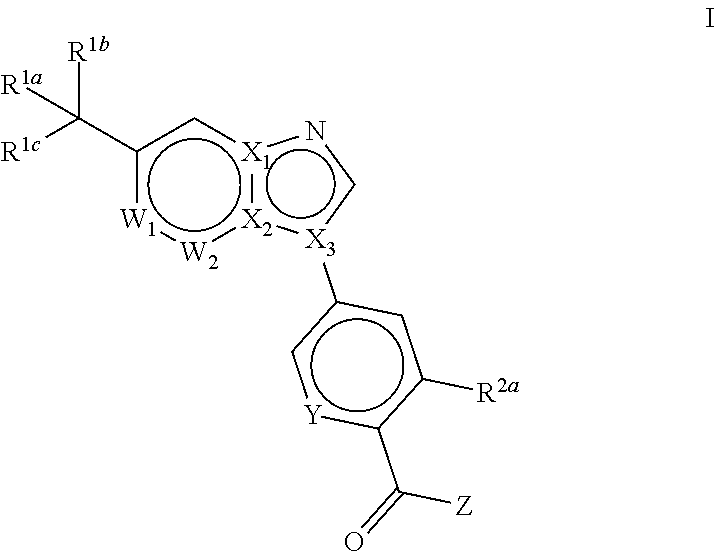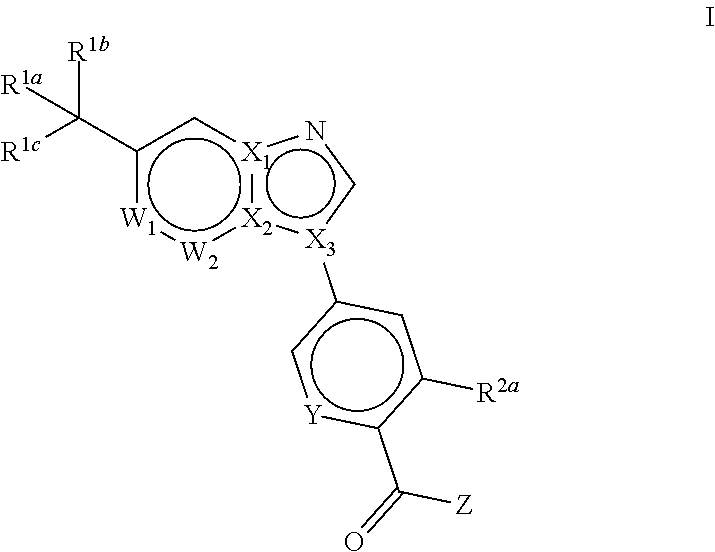Novel compounds and pharmaceutical compositions thereof for the treatment of diseases
a technology of compounds and pharmaceutical compositions, applied in the field of compounds, can solve the problems of opportunistic infections, significant proportion of patients not responding to these therapies, and serious adverse events,
- Summary
- Abstract
- Description
- Claims
- Application Information
AI Technical Summary
Benefits of technology
Problems solved by technology
Method used
Image
Examples
example 1
ynthetic Methods
[0735]1.1. Synthetic Methods Overview
General Methods A: Functionalization of Halogenated Heteroaryl Compound
[0736]Method A1: Alkylation[0737]Method A2: Palladium-catalyzed decarboxylative coupling[0738]Method A3: Negishi coupling[0739]Method A4: Nickel coupling[0740]Method A5: Addition to keto derivative[0741]Method A6: Photochemical reaction[0742]Method A7: Functionalization of halogenated pyridine by metalation[0743]Method A8: Functionalization of halogenated heteroaryl compound by Suzuki coupling / degradation
General method B: Iodination of heteroaryl compounds
General method C: Suzuki coupling of heteroaryl compounds
General methods D: Synthesis of amides from esters[0744]Method D1: Tert-butyl ester hydrolysis then peptide coupling[0745]Method D2: Methyl ester saponification then peptide coupling
General method E: C—H activation of heteroaryl compounds
General methods F: SNAr of di or trisubstituted aniline on halogeno nitro phenyl or pyridine derivatives[0746]Method F...
example 2
on of the Compounds of the Invention
[0982]2.1. Int 1
[0983]In a 15 L jacketed reactor 4-bromo-2,6-difluorobenzoic acid (CAS #183065-68-1; 900 g, 3.80 mol, 1 eq.) is added to SOCl2 (CAS #7719-09-7; 1.4 L, 19.1 mol, 5 eq.) in toluene (2 V, 1.8 mL) under N2 flow at 20° C. (jacket temperature). The suspension is then heated to 80° C. for 17 h (jacket temperature set at 80° C.). The reaction mixture is cooled to 40° C. and concentrated (200 mL of toluene are used to wash the reactor). Toluene (1 V, 900 mL) is added to the residue and the solution is concentrated. The liquid residue (940 g) is dissolved in DCM (5 V, 4.5 L) under N2 and placed into the 15 L reactor. The reaction mixture is cooled to 13° C. (jacket temperature: 5° C.) and a mixture of Et3N (582 mL, 4.18 mol, 1.1 eq.) and cyclopropylamine (276 mL, 4.0 mol, 1.1 eq.) is added over 1.3 h keeping the temperature below 25° C. (jacket temperature set at 5° C. during the addition). The reaction mixture is stirred under N2 at 20° C. ...
example 3
Assays
[1259]3.1. Biochemical Assays
[1260]3.1.1. 33P Radioactive Kinase Assay
[1261]3.1.1.1. Overview
[1262]The principle of the 33P radioactive kinase assay consists in measuring the incorporated 33P into the substrate AMARA peptide when phosphorylated by SIK1, SIK2 or SIK3 using [33P]-g-ATP, which correlates with kinase activity.
[1263]3.1.1.2. Protocol
[1264]The test compounds are prepared as a serial dilution of 10 point dose responses with ⅕ dilution steps in 100% DMSO starting from 2 mM highest concentration, diluted 1 / 20 in water and 5 μL is transferred to the assay plates (Greiner, Cat #651201).
[1265]1% DMSO and 10 μM staurosporine final concentrations are used as negative and positive controls.
[1266]11 μL of enzyme-substrate mixture is added on the assay plates. The reactions are started by adding 9 μL ATP mixture, consisting of non-labeled and 33P-labeled ATP, on the assay plates. Plates are incubated at 30° C. for the time intervals indicated in Table V.
TABLE VConditions for h...
PUM
 Login to View More
Login to View More Abstract
Description
Claims
Application Information
 Login to View More
Login to View More - R&D Engineer
- R&D Manager
- IP Professional
- Industry Leading Data Capabilities
- Powerful AI technology
- Patent DNA Extraction
Browse by: Latest US Patents, China's latest patents, Technical Efficacy Thesaurus, Application Domain, Technology Topic, Popular Technical Reports.
© 2024 PatSnap. All rights reserved.Legal|Privacy policy|Modern Slavery Act Transparency Statement|Sitemap|About US| Contact US: help@patsnap.com










